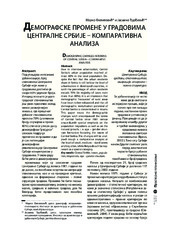Приказ основних података о документу
Demographic changes in towns of Central Serbia: Comparative analysis
Demografske promene u gradovima centralne Srbije - komparativna analiza
| dc.creator | Filipović, Marko | |
| dc.creator | Đurđević, Jasmina | |
| dc.date.accessioned | 2018-12-26T10:54:28Z | |
| dc.date.available | 2018-12-26T10:54:28Z | |
| dc.date.issued | 2007 | |
| dc.identifier.issn | 0354-6055 | |
| dc.identifier.uri | https://raumplan.iaus.ac.rs/handle/123456789/118 | |
| dc.description.abstract | Due to intensive urbanization, Central Serbia's urban population reached almost 60% in the total population. Despite the fact that the urban residents share in Serbia is still bellow the level of urbanization in developed countries, in which the percentage of urban residents exudes 70% (in majority of cases even more than 80%), it is an impression that demographic "resources" of rural areas have bean rather exhausted and that all demographic revitalization potential of Central Serbia is concentrated in towns. This paper treats the demographic changes which encompassed the towns of Central Serbia since 1981 census onwards, with special emphasis on the population migrations as well as on the natural growth, i.e. age - gender structure formation featuring the towns of Central Serbia. The changes will be analyzed trough a comparative analysis at the level of small, medium sized towns and big cities, while Belgrade will be represent as a special category. | en |
| dc.description.abstract | Pod uticajem intenzivne urbanizacije, broj stanovnika Centralne Srbije koji žive u gradovima dostigao je skoro 60% ukupnog broja. I pored toga što je udeo gradskog stanovništva još uvek prilično ispod nivoa razvijenijih zemalja, gde procenat urbanog stanovništva prelazi 70% (u velikom broju slučajeva i preko 80%), stiče se utisak da su demografski "resursi" seoskih područja prilično istrošeni i da je sav potencijal demografske revitalizacije Centralne Srbije koncentrisan u gradovima. U ovom radu biće reči o demografskim promenama koje su zahvatile gradove Centralne Srbije od popisa 1981. godine pa do danas, sa posebnim osvrtom na migracije stanovništva, kao i na prirodno kretanje, odnosno na formiranje starosno - polne strukture gradova. Promene će biti posmatrane kroz komparativnu analizu na nivou malih srednjih i velikih gradova, dok će Beograd biti predstavljen kao posebna kategorija. | sr |
| dc.publisher | Institute of Architecture and Urban and Spatial Planning of Serbia | |
| dc.rights | openAccess | |
| dc.rights.uri | https://creativecommons.org/licenses/by-sa/4.0/ | |
| dc.source | Arhitektura i urbanizam | |
| dc.subject | Central Serbia | en |
| dc.subject | towns | en |
| dc.subject | population | en |
| dc.subject | migrations | en |
| dc.subject | age-gender structure | en |
| dc.subject | Centralna Srbija | sr |
| dc.subject | gradovi | sr |
| dc.subject | stanovništvo | sr |
| dc.subject | migracije | sr |
| dc.subject | starosno-polna struktura | sr |
| dc.title | Demographic changes in towns of Central Serbia: Comparative analysis | en |
| dc.title | Demografske promene u gradovima centralne Srbije - komparativna analiza | sr |
| dc.type | article | |
| dc.rights.license | BY-SA | |
| dcterms.abstract | Филиповић, Марко; Ђурђевић, Јасмина; Демографске промене у градовима централне Србије - компаративна анализа; Демографске промене у градовима централне Србије - компаративна анализа; | |
| dc.citation.issue | 20-21 | |
| dc.citation.spage | 101 | |
| dc.citation.epage | 111 | |
| dc.citation.other | (20-21): 101-111 | |
| dc.citation.rank | M51 | |
| dc.identifier.fulltext | https://raumplan.iaus.ac.rs//bitstream/id/1469/115.pdf | |
| dc.identifier.rcub | https://hdl.handle.net/21.15107/rcub_raumplan_118 | |
| dc.type.version | publishedVersion |

